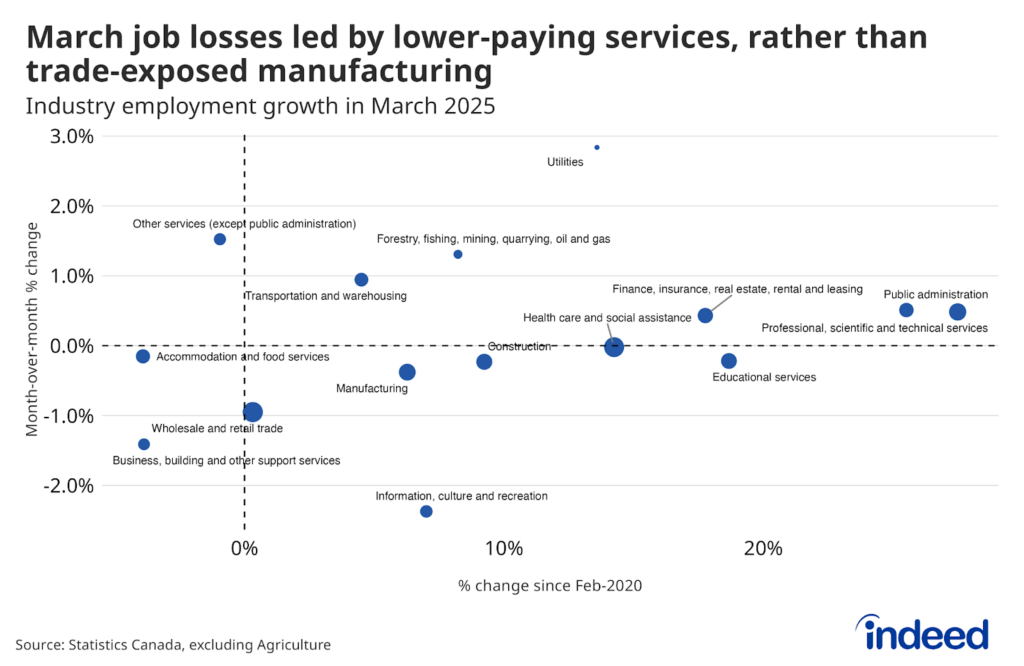Nearly all signs indicate that the Canadian labour market is close to firing on all cylinders. November’s Labour Force Survey beat consensus estimates with a surprising gain of 80,000 jobs, and that pushed the unemployment rate below 6% for the first time since February 2008. Moreover, anecdotal evidence and private sector data suggest that job seekers and employers will continue to feel the effects of increased competition brought on by a labour market that may be approaching full capacity. We see little reason for these trends to reverse in 2018.
Indeed data offer a unique glimpse into the mindset of workers. Job seeker search trends give a sense of people’s preferences and can indicate how they feel about the prospect of finding work. Uncovering how these trends move year to year provides clues on how job seeker preferences and outlooks have changed.
The Canadian labour market tightens
Indeed search data offer evidence of Canadian labour market tightening in 2017. The words “full-time” were among the fastest growing job search terms during the year. In fact, measured as a share of all searches on the Indeed site, searches for full-time work have more than tripled since the start of 2016. Meanwhile, searches containing the term “part-time” have shown only modest growth. This indicates that the economy has strengthened enough to make marginalized workers–unemployed people who have given up looking for work completely and those working part time although they want a full-time job–more optimistic about finding full-time employment.

The increase in searches for full-time work is consistent with other indicators showing the Canadian labour market moving in the right direction. November’s gain of 80,000 jobs marks the 12th consecutive month of rising employment and points to a strong finish for what has been a great year for job growth. Even without a December jobs number, 2017 is already the best year for Canadian job growth since the global financial crisis.
Canada’s employment gains are being driven largely by hiring in the Transportation and Warehousing, and the Professional, Scientific and Technical Services industries. More importantly for the health of the economy, the growing contingent of job seekers looking for full-time work has ample opportunity in the improving labour market. On net, all jobs added so far in 2017 are full-time, while part-time positions actually declined.
The gains in full-time work represents a reversal from the year before, when part-time positions accounted for all job growth. This is a positive development because full-time positions typically offer more stability, higher wages, and benefits not typically found in part-time employment.
In another plus for the economy, Canada’s strong job growth has been accompanied by consistent gains in the percentage of the adult population participating in the labour force. In other words, joblessness is falling as workers become more confident about the economy and come off of the sidelines. That contrasts with a situation in which the unemployment rate falls because discouraged workers leave the labour force and are no longer counted as unemployed.
One final piece of good news: Throughout the end of last year and the first half of 2017, average weekly wages showed little gain. But, in recent months, wages have risen year-over-year in line with the historical average. This signals that employers are raising pay because a tighter labour market has increased the competition to find workers.
Four labour market trends to watch in 2018
The Canadian labour market seems poised to build on its recent success. However, changing workplace dynamics and emerging trends bear watching in 2018. Here’s what we have on our radar screens:
- Employers might have trouble filling jobs: A tightening labour market and rising wages are great news for job seekers. However, this presents challenges for employers, and they are likely to find it more difficult to fill positions. Competition for workers may force them to raise wages further, offer more on-the-job training and relax hiring requirements. However, on the brighter side, tech employers may be able to attract more talent from the US and other places because of the political climate south of the border.
- Rising oil prices could boost jobs: Hiring Lab research has shown how some provincial labour markets were hit hard by the 2014 oil price collapse. Since then, employment growth in oil-producing provinces like Alberta and Saskatchewan has lagged the rest of Canada. But, in the second half of 2017, after nearly two years in the doldrums, oil prices notched small, but steady gains. OPEC’s most recent agreement to limit supply brightens the outlook. If this carries forward into 2018, oil-producing regions should benefit.
- Housing prices may continue to cool: After years of soaring home prices in Toronto, Vancouver and other major cities, housing markets have started to slow. More restrained house price increases ease a risk to the overall economy because that reduces the chances of a sharp real estate correction that would disrupt Canada’s strong employment growth.
- A breakdown in Nafta talks remains a small but worrisome risk: While unlikely, a US pullout from the North American Free Trade Agreement would result in major trade disruptions. Such a breakdown could spur heavy job losses in sectors directly involved in trade with the US, especially manufacturing and agriculture.
Next year holds much promise for the Canadian labour market as momentum from a strong 2017 seems likely to carry into the new year. How employers respond to the tightening labour market and rising competition for talent will be important factors affecting Canada’s overall economic performance in 2018. We just may see how close the Canadian economy can get to full capacity.






